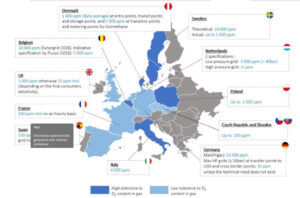Biomethane standards: facilitating renewable gas uptake

Traditionally, gas standards on grid injection and transport use are defined by natural gas properties. Those standards are not always 100% suited to biomethane and may vary across countries.
Differentiating between natural gas and biomethane and meticulously defining parameters such as oxygen, sulphur, and carbon dioxide will facilitate biomethane uptake and cross-border trade in the coming years, enabling the sector to deploy 35 bcm by 2030.
A full analysis on the specifications of different standards related to biomethane was carried out in the framework of the GreenMeUp project.
The report will be made available shortly and this article summarises its key conclusions.
The study also explores the guarantees of origin and standards related to digestates as an end-use product of biomethane.
Gas Quality standard – the oxygen problem
The creation of gas quality standards EN 16726 by CEN (European Committee for Standardisation), exemplifies the collaborative effort towards regulatory alignment and market integration.
The standard aims to enhance the interoperability of gas systems across EU member states by establishing technical rules such as gas pressure equipment and operation.
However, challenges persist in achieving uniformity across various countries. This is because the standard is voluntary, and countries can choose different standards if they wish (and often do).
The omission of parameters like the Wobbe Index and discrepancies in permissible oxygen levels in the grid, highlight areas of contention for renewables, such as biomethane, from one country to another.
For example, in Denmark, the legislation limits oxygen levels for biomethane injected into the grid to 0.5% mol/mol at entry points and transit and 0.1% at storage points. Italy has an oxygen limit up to 0.6% mol/mol for biomethane injected into the gas grid. While France has a lower tolerance of 0.001% mol/mol on hourly basis.
Controlling oxygen levels in the gas grid is important in avoiding corrosion in both underground and above-ground facilities, as well as avoiding the formation of "black powder" in high-pressure grids.
There are also risks of combustion, change in gas quality due to reaction and oxidation and possible microbial growth in the gas storage environment.
But applying different level requirements creates variations in the gas quality and hampers cross-border trade of biomethane.
Increased harmonisation is expected thanks to the revised version of the standard (to be published in 2025) by incorporating normative recommendations for oxygen requirements, Wobbe Index and review the parameters present in the current standard, including hydrogen content and adapted minimum value for relative density, sulpbur, and methane number.
Making biomethane the standard
While standard EN16726 defines gas quality standards for natural gas, EN1623-1 and EN1623-2 focus on injection, integration and safe utilisation of biomethane into the natural gas grid and for use in transport.
It is essential to recognise that biomethane possesses unique characteristics that may not be fully addressed by existing standards designed primarily for natural gas.
Siloxanes, terpenes, amines, and other components specific to biomethane present distinct challenges that demand specialised attention, which is what both the EN16723 -1 and EN16723-2 cover to ensure a smooth uptake of biomethane.
But then again, oxygen requirements remain the biggest challenge coupled with the different requirements existing for the Wobbe Index, the calorific values and relative density of biomethane.
Currently there is a working group collecting information for the revision of both EN 16723-1 and EN 16723-2 standards and will hopefully come with a different approach to address such discrepancies and enhance the easy integration of biomethane into the grid and the overall energy mix towards the deffossilissation of our economy and the achievement of climate-neutrality.
This article was written by George Osei Owusu – project and technical officer at the EBA.


















